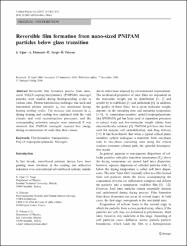Ara
Toplam kayıt 16, listelenen: 1-10
Small molecule desorption from a swelling polymeric glass in polymer solution: Energy transfer method
(Elsevier Science Sa, 2005-07-15)
Direct energy transfer (DET) method conjunction with fast transient fluorescence (FTRF) technique were used to study small molecule desorption from a swelling poly(methyl methacrylate) (PMMA) glass in polymer solution, ...
Percolation approach to film formation from surfactant-free polystyrene particles
(Taylor & Francis, 2005-09)
In this study, a film formation process from surfactant-free polystyrene (PS) latex particles is reported. Steady state fluorescence (SSF) and photon transmission (UVV) techniques were used to study the evolution of film ...
Film formation from nano-sized polystyrene latex particles
(John Wiley & Sons Ltd, 2005-05)
This work reports on the steady state fluorescence (SSF) technique for studying film formation from surfactant-free, nano-sized polystyrene (PS) latex particles prepared via emulsion polymerization. The latex films were ...
Films formed from polystyrene latex/clay composites: A fluorescence study
(Springer New York, 2005-07)
This study reports a steady-state fluorescence (SSF) technique for studying film formation from surractant-free polystyrene (PS) latex and Na-montmorillonite (SNaM) composites. The composite films were prepared from pyrene ...
Time evolution of film formation from polystyrene particles: a percolation approach
(Springer, 2005-12)
This work reports the film formation process from surfactant-free polystyrene (PS) latex particles. Steady state fluorescence and photon transmission techniques were used to study the evolution of film formation. The films ...
Small molecule desorption prior to dissolution of a polymeric glass
(Wiley Subscription Services, Inc., A Wiley Company, 2006-07-15)
Poly(methyl methacrylate) (PMMA) discs in various molecular weights (M-w) were prepared by free-radical polymerization. Pyrene (Py) was introduced during polymerization as a fluorescence probe. In situ steady state ...
Effects of annealing on morphology of polymer/polymer (PS/PMMA) blend; a fluorescence study
(John Wiley& Sons Inc, 2006-05-05)
Steady state fluorescence (SSF) technique conjunction with optical microscopy were used to study the morphology of polystyrene (PS)/poly(methyl methacrylate) (PMMA) blend upon annealing above glass transition in elevated ...
Reversible film formation from nano-sized PNIPAM particles below glass transition
(Springer-Verlag, 2007-01)
Reversible film formation process from nano-sized Poly(N-isopropylacrylamide) (PNIPAM) microgel particles were studied during heating-cooling cycles at various rates. Photon transmission technique was used and transmitted ...
Film formation from TiO2-polystyrene latex composite: a fluorescence study
(Taylor & Francis Group, 2007-03-01)
This work reports the use of the steady state fluorescence (SSF) technique for studying film formation from TiO2 covered polystyrene (PS) latex particles. The composite films were prepared from pyrene (P)-labeled PS particles ...
Film formation from PS latex doped PNIPAM hydrogels at various heating and cooling rates
(VSP BV, Brill Academic Publishers, 2008-05-01)
Film formation from polystrene (PS) latex doped poly(N-isopropylacrylamide) (PNIPAM) hydrogels was studied by using photon transmission technique. The transmitted light intensity, It, was monitored during film formation ...
















